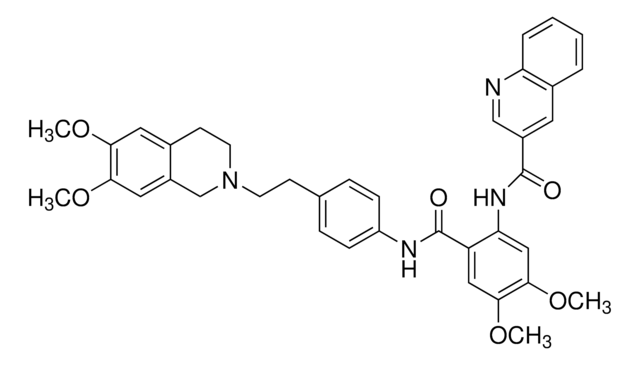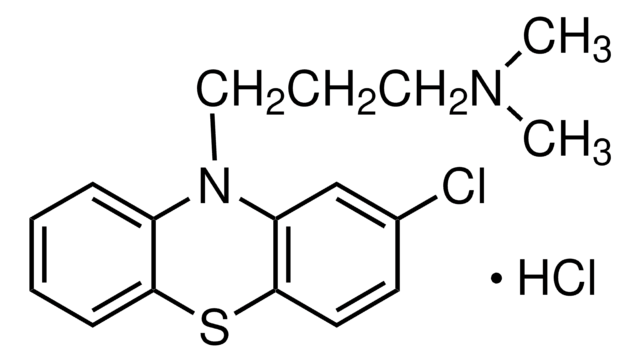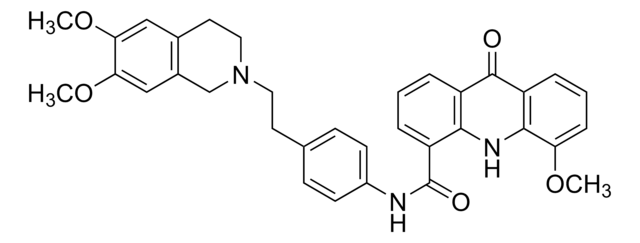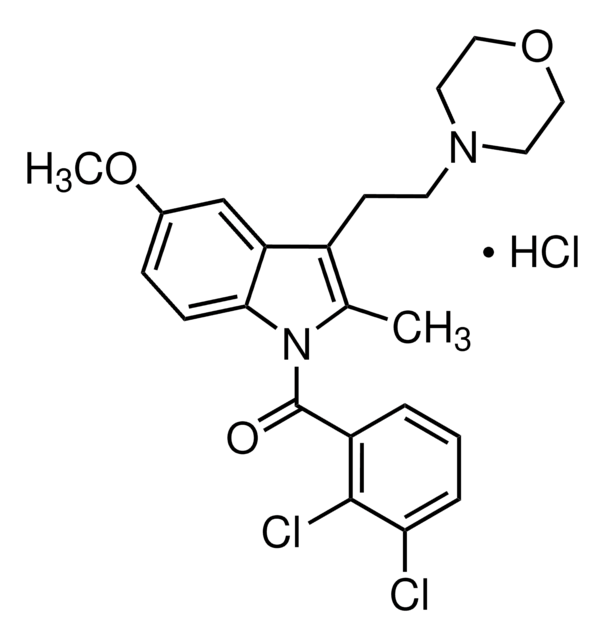Alle Fotos(1)
Wichtige Dokumente
SML3678
ML-SI3
≥98% (HPLC)
Synonym(e):
N-[2-[4-(2-Methoxyphenyl)-1-piperazinyl]cyclohexyl]benzenesulfonamide
Anmeldenzur Ansicht organisationsspezifischer und vertraglich vereinbarter Preise
Alle Fotos(1)
About This Item
Empirische Formel (Hill-System):
C23H31N3O3S
CAS-Nummer:
Molekulargewicht:
429.58
MDL-Nummer:
UNSPSC-Code:
12352200
NACRES:
NA.77
Empfohlene Produkte
Qualitätsniveau
Assay
≥98% (HPLC)
Form
powder
Farbe
white to beige
Löslichkeit
DMSO: 2 mg/mL, clear
Lagertemp.
-10 to -25°C
Biochem./physiol. Wirkung
Four-diastereomer racemate with a cation channel TRPML1-blocking and TRPML2-activating activity, while exhibiting much weaker TRPML3 potency
ML-SI3 is a 4-diastereomer racemate (2 cis and 2 trans isomers) with a cation channel TRPML1-blocking (IC50 = 3.1 μM/trans, 18.5 μM/cis against 5 μM ML-SA1-induced cellular calcium response) and TRPML2-activating activity (EC50 = 3.3 μM/trans, 9.4 μM/cis), while exhibiting much weaker TRPML3 potency (EC50 = 28.5 μM/trans, IC50 = 29.0 μM/cis). ML-SI3 is shown to compete against ML-SA1 for binding the same TRPML1 hydrophobic cavity. Comparing with ML-SI1 (GW405833), ML-SI3 is more potent and not agonist-dependent, effectively antagonizing against TRPML1 activation by both MK6-83 and ML-SA1.
Lagerklassenschlüssel
11 - Combustible Solids
WGK
WGK 3
Flammpunkt (°F)
Not applicable
Flammpunkt (°C)
Not applicable
Hier finden Sie alle aktuellen Versionen:
Analysenzertifikate (COA)
Lot/Batch Number
It looks like we've run into a problem, but you can still download Certificates of Analysis from our Dokumente section.
Wenn Sie Hilfe benötigen, wenden Sie sich bitte an Kundensupport
Besitzen Sie dieses Produkt bereits?
In der Dokumentenbibliothek finden Sie die Dokumentation zu den Produkten, die Sie kürzlich erworben haben.
Philip Schmiege et al.
Structure (London, England : 1993), 29(11), 1295-1302 (2021-06-26)
Transient receptor potential mucolipin 1 (TRPML1) regulates lysosomal calcium signaling, lipid trafficking, and autophagy-related processes. This channel is regulated by phosphoinositides and the low pH environment of the lysosome, maintaining calcium levels essential for proper lysosomal function. Recently, several small
Wuyang Wang et al.
Proceedings of the National Academy of Sciences of the United States of America, 112(11), E1373-E1381 (2015-03-04)
Upon nutrient starvation, autophagy digests unwanted cellular components to generate catabolites that are required for housekeeping biosynthesis processes. A complete execution of autophagy demands an enhancement in lysosome function and biogenesis to match the increase in autophagosome formation. Here, we
Unser Team von Wissenschaftlern verfügt über Erfahrung in allen Forschungsbereichen einschließlich Life Science, Materialwissenschaften, chemischer Synthese, Chromatographie, Analytik und vielen mehr..
Setzen Sie sich mit dem technischen Dienst in Verbindung.








